A History of Soy Milk
A history of the beige, beany liquid that was once predicted to save the world.
We live in a golden age of milks. You can crown your latte with a foam of almond, coconut, oat, or pea; dunk your cookies in hemp or rice; drown your bran flakes in hazelnut, flax, or quinoa. Any legume, grain, seed, or nut, it seems, can be wrung into a mild and milky fluid.
Among this next-gen crowd of plant-based milk analogs, soy milk, the first widely available nondairy milk, stands apart as the unfashionable older sister—a bit dowdy, a bit behind the times. But within the family of soy foods, soy milk is a relative newcomer, with a thin history prior to the 20th century. Other soy foods, such as tofu, tempeh, and yuba, have long been used in a variety of ways in multiple East Asian cuisines, but soy milk played only a limited role in traditional diets in China. The liquid produced from ground-up soybeans that were soaked overnight, it was sometimes served as part of a Chinese breakfast, warmed up and sweetened; seasoned with salt, it became a dipping sauce for youtiao, or fried crullers. Most often, it was not a final product but an intermediate step in the production of tofu.
Unlike the ubiquity of miso or soy sauce, the popularity of soy milk in the US is not the result of the adoption of a traditional foodstuff by a widening group of consumers. In the hands of American technologists, Adventist missionaries, hippie environmentalists, and East Asian entrepreneurs, soy milk was always viewed as a food of the future, a salvific beige fluid that held the solution for all our nutritional, spiritual, and environmental travails. For decades, soy milk’s acolytes in the US waited for its time to come, believing that a world that embraced soy milk was a world where the future could overcome the woes of the past. But, although soy milk’s day did arrive at last, its moment in the spotlight of American consumer affections now seems vanishingly brief.
The Miracle Drink

Serious Eats / Vicky Wasik
One way of understanding soy milk is as a product one turns to when dairy is unobtainable or off-limits—a kind of milk of last resort. During the First and Second World Wars, when meat and dairy were rationed, soy milk and other soy foods sometimes played this role: stand-ins for the real stuff, until the war was over. For the lactose-intolerant, and others who could not drink ordinary milk for reasons of health or conviction, soy was a consolation prize, a mock milk that provided a semblance of dairy’s qualities and some of its nutritional virtues.
But there is another way of thinking about soy milk—not as a substitute milk but as a triumph and improvement over conventional dairy. Viewed in this way, soy milk is not a milk of scarcity and deprivation but a potentially ideal beverage, one that could be engineered to better serve human needs.
This also aligns with the industrial vision of soy presented by the US government, which began promoting soy cultivation in the late 19th century. In the US, soybeans were never intended primarily as food for human consumption; they were the feedstock for a new model of agriculture that was closely integrated with industry, in which soy served as the raw material for a range of processes and products, including animal feeds, oils, fuels, plastics, and pharmaceuticals. Soy milk was just one of many uses for the versatile bean, a way of capitalizing on its protein and fat content through food processing.
Henry Ford, the founder and chairman of the Ford Motor Company, was one of soy milk’s most ardent champions. Ford was deeply invested, personally and financially, in a soybean future. He owned hundreds of acres of soybean fields and funded extensive research into new industrial uses for soy oils and meals, including a “soybean car” made entirely from a soy-based plastic resin. Although he was a vegetarian, his commitment to soy foods derived not from a concern for animal welfare but from his love for technological efficiency. The cow was “the crudest machine in the world,” Ford fulminated, a slow and filthy way of making milk. “It is a simple matter to take the same cereals that the cows eat and make them into a milk which is superior to the natural article and much cleaner,” he explained in the 1920s. Why not skip the middleman and get the milk directly from beans? In 1934, Ford opened a demonstration soy-milk plant in his Dearborn, Michigan, research center. Flavored with imitation banana, his prototype was said to be particularly popular with his Filipino employees, but few others seem to have been convinced.
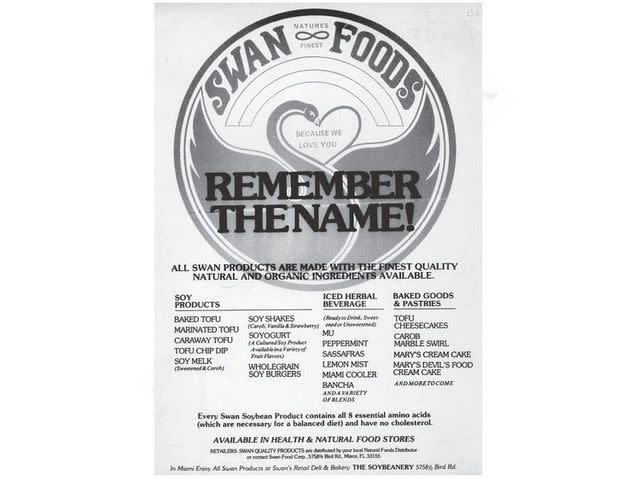
Serious Eats / William Shurtleff
Why wouldn’t consumers give soy milk a chance? If dairy milk had once been dangerous and frequently adulterated—a white cup of death, teeming with TB, listeria, and other pathogens—pasteurization was mandated and widespread by the 1930s, and consumers had few doubts about the safety or cleanliness of dairy. While Asian-American communities maintained their soy-food traditions, most other US consumers associated soy with the unpleasant ersatz foods of wartime (soybean “coffee,” soy loaf), or with inedible products like plastics and varnishes. Why drink soy milk if you didn’t have to?
There was one big exception. Seventh-Day Adventists, for whom vegetarianism is an article of faith, have been pioneers in food technology since the days of John Harvey Kellogg’s Battle Creek Sanitarium in the late 19th century, and thus have invented an array of plant-based fake meats with irresistible names like Nuttolene, Protose, FriChik (which is still on the market), and Vegelona.
Adventism’s soy-milk saint is Harry W. Miller, a doctor and medical missionary who spent decades in Japan and China, where he first became interested in soy foods. In 1931, Miller established an Adventist medical center in Shanghai, where cow’s milk was scarce and costly and where, though a handful of commercial soy-milk factories had recently begun operations, soy milk was usually not considered suitable for young children. In a series of feeding experiments, Miller and his medical staff showed that infants raised on soy milk were healthier than those given cow’s milk or Western baby foods; only breastfed babies did better. Cheaper and more nutritious than dairy milk, soy milk, Miller believed, was a perfect food—not just for babies, but for everyone—and he planned to build a soy-milk factory in Shanghai to make it more widely available.
There were just two problems: the flavor, and the farting. As traditionally prepared in China, soy milk often had a bitter taste and a peculiar flavor that soy-industry researchers call “beany.” “Beany” has variously been described as chalky, cardboard-y, or fishy; resembling sweaty feet; or reminiscent of licking a wet popsicle stick—all of which hint at its prismatic unpleasantness, particularly to Western palates. Soy milk also had a well-earned reputation for causing digestive distress, which was why Chinese parents did not typically feed it to young children.
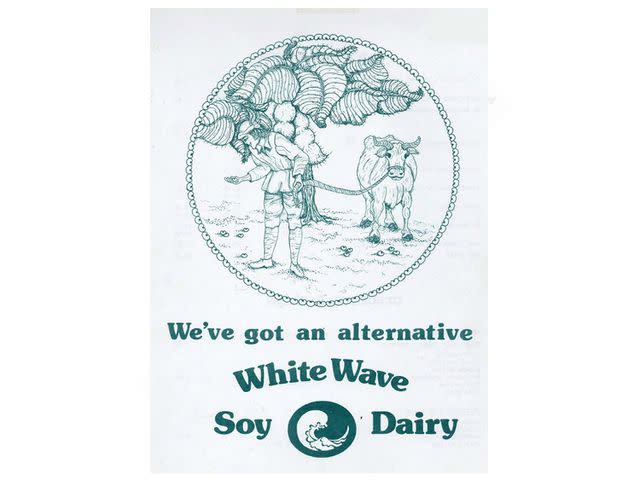
Serious Eats / William Shurtleff
According to Matthew Roth—who tells Miller’s story in his fascinating history of soy, Magic Bean: The Rise of Soy in America—Miller mitigated soy milk’s fartiness by extending the cooking time and tempered its bitterness by adding sugar, but the beaniness remained. Then, while he toiled over a hot cauldron of soy slurry, God took the ladle. As Miller recounted in his memoir, “I heard a divine voice behind me that said, ‘Why don’t you cook it longer with live steam?’” Steam distillation, God’s proposed method, was a processing technique commonly used to deodorize oils, and it swept off many of the volatile molecules responsible for the ugly flavors.
Miller’s Vetose Soya Milk factory began producing a bland, un-beany soy milk in Shanghai in 1937—a terrible time and place to start a new business. When the Japanese military invaded, Miller and his family fled, and the factory was destroyed in the ensuing fighting.
Alongside his eldest son, Willis, Miller started over in Ohio, manufacturing Soy-A-Malt for adults and Soyalac for children, and trying to persuade Americans to give soy milk a chance. Miller beat the drum in pamphlets and lectures: Soy milk was safer than milk; it was a complete protein source; it was alkalinizing; it was far easier to digest than cow’s milk. It was purer, healthier, better than milk.
It didn’t catch on. Postwar America hankered for giant strawberry milkshakes, spilling over the brims of frosty frappé glasses, and gave its children cartons of milk with their school lunches. The 1950s were the century’s peak decade for milk consumption, and soy milk remained a beverage for people with special needs—the lactose-intolerant, diabetics, Adventists, health faddists. In 1950, Miller abandoned his company and the country—passing the torch to Loma Linda, another Adventist food company—and traveled the world evangelizing for soy milk and advising on the creation of soy-milk factories in Japan and Indonesia.
Entering the Mainstream
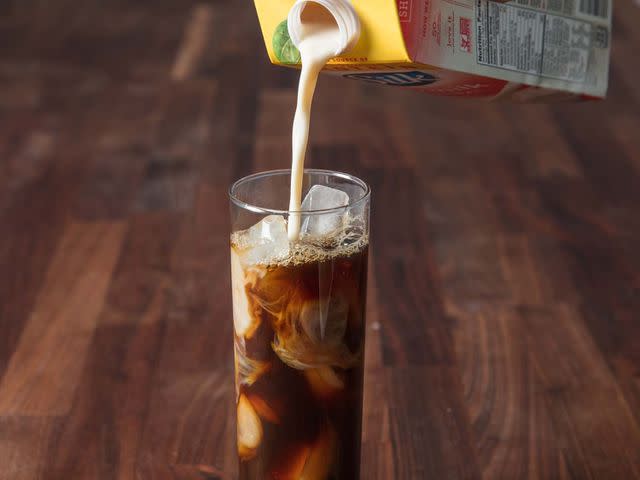
Serious Eats / Vicky Wasik
Despite the earnestness of Miller’s soy-milk mission, something was missing. It wasn’t enough for soy milk to be good for you, and for it to taste good enough. For soy milk’s day to dawn, it had to become desirable, craveable, delicious.
Enter Vitasoy. Founded by Kwee Seong Lo, a Malaysian-born entrepreneur, Vitasoy was proof that soy milk could have mass appeal. Lo had first learned about soy milk at a US embassy–sponsored talk in Shanghai in the mid-1930s. He began manufacturing it in Hong Kong during the war, initially to feed refugees, then selling it in half-pint milk bottles. Sales were slow: Like milk, soy milk spoiled quickly and needed refrigeration. The business soon ran out of money.
Lo tried again in 1945, after the war had ended. His breakthrough was to liberate soy milk from the bondage of its resemblance to milk, which didn’t have much of a market in East Asia anyway. Instead, Lo packaged soy milk as though it were a soft drink, in curvy glass bottles crowned with metal caps; he also worked with a chemical engineer to make it shelf-stable, as imperishable as soda pop. Vitasoy came sweetened and vitamin-fortified, in flavors including chocolate and malt. It was sold chilled in the summer and warm in the winter. Ads promised Vitasoy drinkers that they would become taller, stronger, and more beautiful. (“The drink’s main drawback is that it tastes a good deal like liquid library paste,” Time magazine snootily opined, in 1968.)
People bought it, lots of it. By 1962, Vitasoy had become the best-selling soft drink in Hong Kong, surging ahead of Coca-Cola, Pepsi, and 7 Up. Its success attracted worldwide attention, including from international aid organizations, such as USAID and UNICEF. These groups saw soy milk as an inexpensive and tasty source of protein, and a weapon in the global war against hunger. Beyond those humanitarian goals, they saw geopolitical gains: In Cold War calculations, the oppressed were potential recruits to anti-capitalist ideologies. Feeding soy milk to the world’s hungry was thus a hedge against global Communist domination.
It was also a business opportunity. Monsanto, the US agrochemical company, partnered with Vitasoy to develop Puma, a bright-yellow, banana-flavored soy drink, which it introduced to Guyana in 1969. (The drink’s name was intended “to convey the idea of the energy and vitality inherent in its protein content,” explained a Monsanto rep.) Soon after, The Coca-Cola Company began selling Saci, a vitamin-boosted, artificial-fruit-flavored rival soy beverage, in Brazil. Notably, these companies do not appear to have considered soy milk for the US market. While it was suitable for the so-called developing world, soy milk was perceived as a trickier proposition in the consumerist, dairy-besotted West.

Even as multinational corporations were getting into the global soy-foods business, and even as soy became more and more deeply embedded in the industrial agricultural system, a countercultural, grassroots movement began to embrace the bean, too. The idea of soy’s superiority, earlier preached by Ford and the Adventists, finally began to gain traction when cloaked in the ethic of environmentalism. Frances Moore Lappé’s influential Diet for a Small Planet, published in 1971, argued that a vegetarian lifestyle could prevent a global crisis. And soy, with its complete set of amino acids, was the bean that could save the planet.
The quality of commercial soy milk had also improved, thanks to food science. In the late 1960s, flavor researchers at Cornell University had definitively identified an enzyme called lipoxygenase as the source of soy milk’s reviled beany flavor. When soaked soybeans were ground at temperatures below 180°F (82°C), lipoxygenase went on a catalytic rampage, converting fatty acids into a whole spectrum of rancid-tasting and unpleasant molecules. Scientists also pinpointed oligosaccharides, or complex sugars, as the culprits behind soy-milk flatulence. By the 1970s, it was possible to manufacture a bland, creamy, and fartless soy milk—a truly inoffensive beverage, suitable for mass consumption.
Still, soy milk retained its distinctly crunchy, alternative vibe. Dead giveaway: Many of the soy milks sold in the US in the 1980s—from brands like Edensoy, Westbrae, and Swan Soy Melk—came in carob flavor, not chocolate. For many Reagan-era Americans, soy was the food equivalent of a hairy-legged gal in Birkenstocks: joyless and unappealing to most people, but there was always a niche of enthusiasts who couldn’t get enough.
Soy milk’s reputation began to change in the 1990s, when stories about soy’s miraculous health benefits began circulating in the media. In 1995, The New England Journal of Medicine published research that linked soy protein consumption with lower levels of “bad” LDL cholesterol and increased levels of “good” HDL cholesterol. Four years later, the FDA began allowing makers of soy products to advertise this benefit on their packaging, which is why you often see a heart logo on soy-milk cartons, a symbol of cardiac health. There were all kinds of other health benefits attributed to soy; it was supposed to reduce the risk of breast and prostate cancers, protect bones against osteoporosis, temper the symptoms of menopause, and supercharge weight loss.
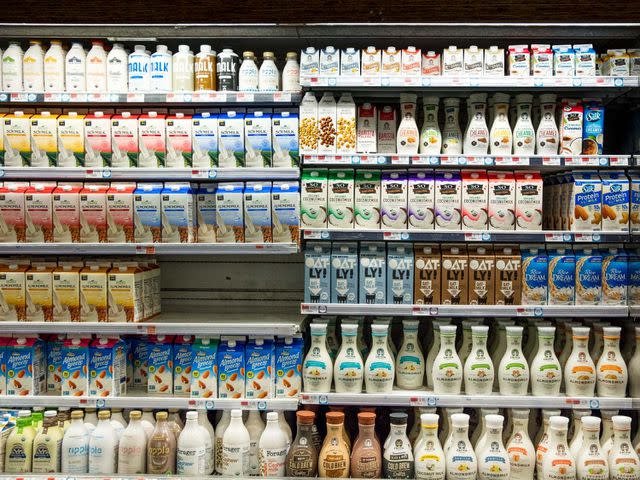
Serious Eats / Vicky Wasik
Suddenly, everyone seemed to be drinking soy milk, not just health nuts, vegans, and the lactose-wary. Guys trying to avoid prostate issues, older women dealing with hot flashes, dieters hoping to slim down. Soy-milk sales began a dramatic rise, and brands like White Wave’s Silk—founded in countercultural Boulder, Colorado, in the late 1970s—became huge sellers. William Shurtleff, who helped make soy a hippie staple in the 1970s and now runs the Soyinfo Center, a soy education and advocacy organization, notes that the rise in sales was in part due to a change in merchandising. “Soy milk used to be sold in the center of the supermarket,” he says, next to cornmeal, canned soups, or other random, unrelated items. “When White Wave became the biggest seller of soy milk, it’s because they moved soy milk out of the middle of the supermarket and put it where people would look for it—next to the milk.” Soy milk had gone mainstream.
And people kind of liked it. For decades, soy-milk manufacturers had struggled to convince US consumers that their product wasn’t repulsive. “Soy milk has a mild, smooth flavor nearly everyone likes,” swore an ad for Loma Linda canned soy milk in the May 30, 1944, Tampa Tribune. “A little heaven on earth,” promised Swan Foods’ Soy Melk, in 1977. But it was only in the 1990s, when soy milk became whiter, creamier, and sweeter, and came in vanilla, eggnog, chai mocha, and other tantalizing dessert-like flavors, that a broad swath of consumers started to give it a chance. You can still get carob-flavored soy milk, but you’re much more likely to find chocolate.
Decline and Fall
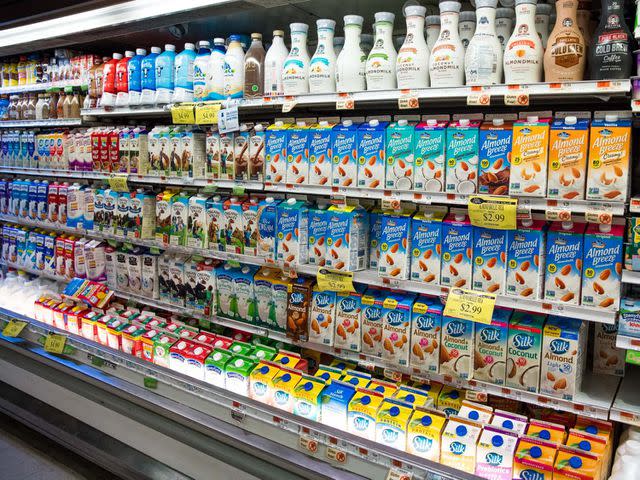
Serious Eats / Vicky Wasik
As so often happens in nutrition, subsequent research walked back some of the dramatic benefits of soy that earlier studies had found. But soy wasn’t simply another superfood that failed to deliver: There was a full-blown backlash against the bean, one directed against the same molecules that had been touted as the source of its health-giving powers.
Daidzein and genistein, soy’s supposedly miracle-working isoflavones, are phytoestrogens—that is, plant-derived molecules that bear a structural resemblance to estrogen. This association with the so-called “female hormone” (though, real talk, both men and women produce it) triggered all sorts of fears. Some worried that soy was an endocrine disruptor, causing early puberty in girls and increasing, rather than lowering, the risk of cancer. Further out on the fringes, soy was denounced as part of a liberal plot to feminize American males by draining them of their precious testosterone, causing an epidemic of “girlie men.” At the same time, soybeans were increasingly implicated in what were seen as the wider problems of industrial agriculture: monoculture, clear-cutting rain forests, GMOs. To many eco-conscious people, soy didn’t seem quite so virtuous anymore.
The fringe anti-soy narrative—a toxic stew of misogyny and homophobia, with some anti-Asian racism thrown in—is clearly offensive and wrong. And fears about endocrine disruption (registration required) and increased cancer risks also seem to be exaggerated or misguided. “Do you know what the most nutritious nondairy milk is?” Shurtleff demanded when I interviewed him. “It’s soy!”
And yet. Have you ever paused before the lavish selection of nondairy options in the supermarket, pondered the red carton of Silk or the beige-and-blue brick of Edensoy, wondered whether soy milk was actually that good for you, and then chosen one of the newer, hipper alternative milks instead?
This brings us to where we are today: soy milk’s exhausted prospects. After hitting a peak of $1.2 billion in 2008, US soy-milk sales began a steep decline. Almond milk, not soy, is now the top nondairy-milk choice in the US, and coconut is hot on its heels.
We are living in the future that soy milk helped create, a world where we no longer believe we need the cow for its milk, and where plant-based meat alternatives are promoted as both world-saving techno-foods and legitimately delicious. Where a cheese-loving, ice cream–eating, totally-down-with-lactose gal like me might tarry in front of the dairy alternatives and pick one just because it looks good. Is there room for soy milk in this plant-based consumer economy?
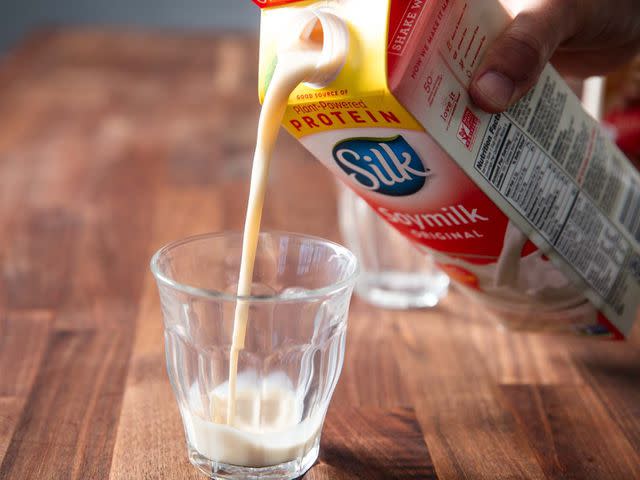
Serious Eats / Vicky Wasik
At the bodega down the block, I have to search out the soy among the array of pea, rice, almond, and coconut; the cartons of organic milk; the plastic jugs of conventional 2% and skim. Back at home, I pour myself a glass of plain, unsweetened soy. It is beige, bland, nondescript, with a faint, almost vegetal aroma. Its unremarkable flavor takes me back to the 1990s, before Whole Foods arrived in my suburban hometown, to the cluttered aisles of the local health food store, to the can-do stoicism of my teenage experimentation with veganism. In other words, it tastes like nostalgia.
June 2018
Read the original article on Serious Eats.